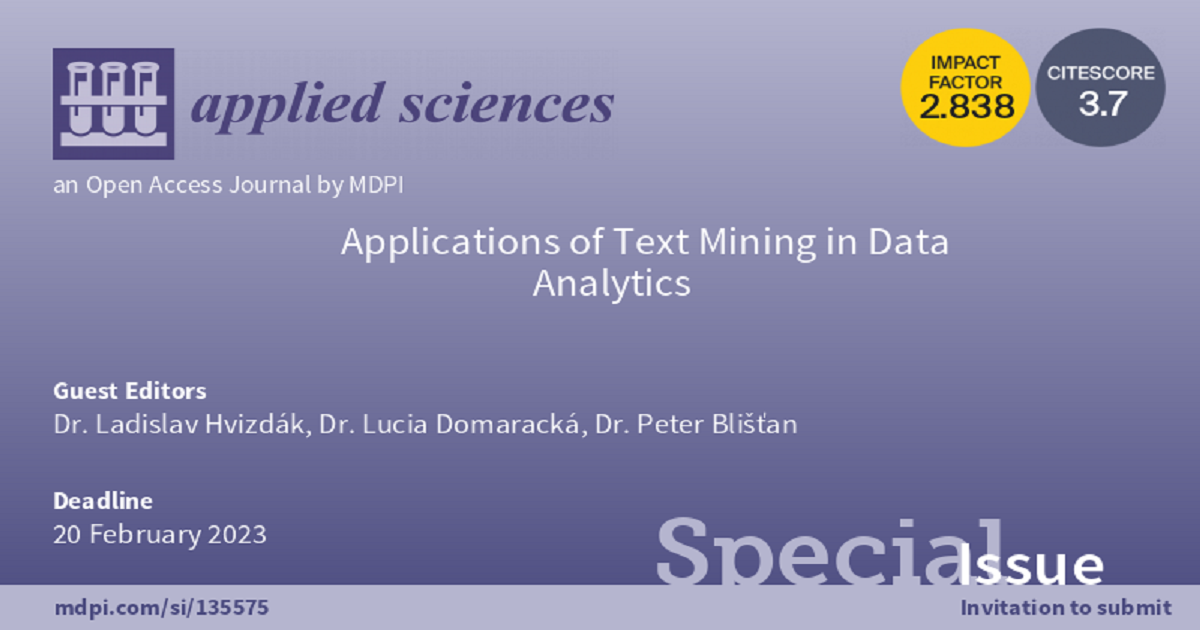Applications of Text Mining in Data Analytics
A special issue of Applied Sciences (ISSN 2076-3417). This special issue belongs to the section "Computing and Artificial Intelligence".
Deadline for manuscript submissions: closed (20 September 2023) | Viewed by 3671

Special Issue Editors
Interests: information systems(IS); GIS in modeling the historical montane landscape; 2D and 3D models and historical research of the landscape for geotourism needs; various interactive forms of the presentation of 2D and 3D models through modern techniques (stereoscopy, holography, etc.)
Interests: mining; geotourism; mineral exploration; mineral economics
Interests: geographic information systems (GIS); 3D visualization; spatial modelling; applied geology; remote sensing and data collection; geostatistics; CAD systems
Special Issues, Collections and Topics in MDPI journals
Special Issue Information
Dear Colleagues,
Text mining technology is now widely used for a wide range of government, research and business needs. All of these groups can use text mining to manage records and find documents relevant to their day-to-day activities. Scientific researchers incorporate text mining approaches in efforts to organize large text data sets (solving the problem of unstructured data) to determine the ideas communicated through text, and to support scientific discoveries in various fields.
This Special Issue will be devoted to new perspectives on text mining and resulting applications, as well as text mining in the age of social media.
The topics discussed in this Special Issue will focus on the latest methods and advances in text mining.
Dr. Ladislav Hvizdák
Dr. Lucia Domaracká
Dr. Peter Blišťan
Guest Editors
Manuscript Submission Information
Manuscripts should be submitted online at www.mdpi.com by registering and logging in to this website. Once you are registered, click here to go to the submission form. Manuscripts can be submitted until the deadline. All submissions that pass pre-check are peer-reviewed. Accepted papers will be published continuously in the journal (as soon as accepted) and will be listed together on the special issue website. Research articles, review articles as well as short communications are invited. For planned papers, a title and short abstract (about 100 words) can be sent to the Editorial Office for announcement on this website.
Submitted manuscripts should not have been published previously, nor be under consideration for publication elsewhere (except conference proceedings papers). All manuscripts are thoroughly refereed through a single-blind peer-review process. A guide for authors and other relevant information for submission of manuscripts is available on the Instructions for Authors page. Applied Sciences is an international peer-reviewed open access semimonthly journal published by MDPI.
Please visit the Instructions for Authors page before submitting a manuscript. The Article Processing Charge (APC) for publication in this open access journal is 2400 CHF (Swiss Francs). Submitted papers should be well formatted and use good English. Authors may use MDPI's English editing service prior to publication or during author revisions.
Keywords
- natural language processing (NLP)
- machine learning
- ontologies
- vocabularies
- custom dictionaries
- open architecture
- ETL (extract, transform, load)
- social media
- quality data







